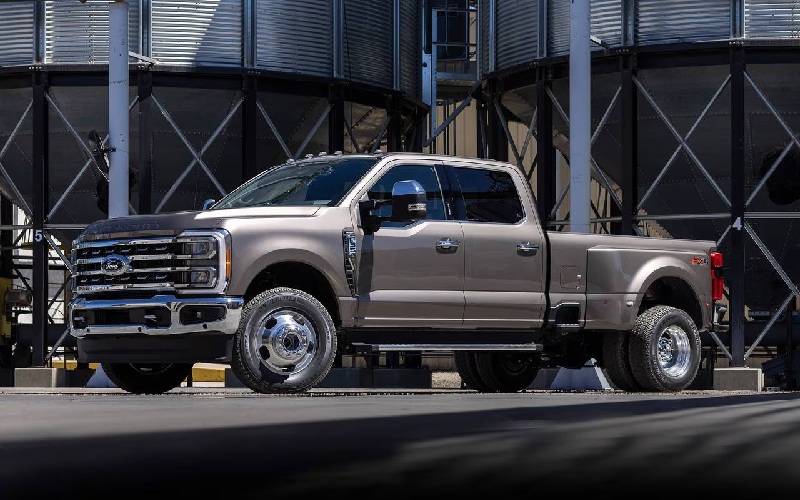2025 Ford F-350 Super Duty Exhaust System Specifications
The Ford F-350 Super Duty continues to define the heavy-duty truck category, combining cutting-edge technology, versatile performance, and refined design. With notable updates for the new model year, the F-350 Super Duty delivers an enhanced driving experience for trades professionals and enthusiasts alike. Let’s take a closer look at what makes the exhaust system of […]
The Ford F-350 Super Duty continues to define the heavy-duty truck category, combining cutting-edge technology, versatile performance, and refined design. With notable updates for the new model year, the F-350 Super Duty delivers an enhanced driving experience for trades professionals and enthusiasts alike. Let’s take a closer look at what makes the exhaust system of the Ford F-350 Super Duty stand out as a marvel of modern engineering.

System Architecture and Components
Under the chassis of the F-350 Super Duty lies a comprehensively engineered exhaust system designed to maximize performance, durability, and efficiency. The system begins at the exhaust manifolds, which feature high-silicon, molybdenum-alloyed cast iron construction for exceptional heat resistance and durability. These manifolds connect to the engine’s cylinder heads with multi-layer steel gaskets and high-strength fasteners treated with anti-seize compounds to ensure long-term serviceability.
For diesel-powered models equipped with the 6.7-litre Power Stroke turbodiesel V8, the exhaust manifolds channel exhaust gases into a variable-geometry turbocharger before entering the diesel exhaust fluid (DEF) system. This advanced emissions control technology injects a precise amount of DEF into the exhaust stream to convert nitrogen oxides into harmless nitrogen and water.
In gasoline-powered Super Duty trucks equipped with the 7.3-litre Godzilla V8, the cast-iron exhaust manifolds direct gases through dual catalytic converters, designed to reduce harmful emissions while minimizing back pressure efficiently. The catalytic converters utilize precious metal catalysts spread across a honeycomb ceramic substrate with a density of 900 cells per square inch, offering an optimal balance between emissions control and flow characteristics.
All F-350 models feature a diesel particulate filter (DPF) or catalytic converter system followed by a series of resonators and mufflers engineered to reduce noise while maintaining optimal exhaust flow. The system terminates with a chrome-tipped exhaust outlet integrated into the rear bumper on single-rear-wheel models, while dually models feature a side-exit design ahead of the rear wheels.
Performance Enhancements for 2025
For the latest model year, Ford engineers have implemented significant improvements to the F-350 Super Duty exhaust system. The updated design features larger-diameter tubing—increasing from 10.2 centimetres to 11.4 centimetres on diesel models—which reduces back pressure and improves exhaust flow by approximately 13% compared to previous generations.
The redesigned muffler incorporates an innovative three-chamber design with carefully calibrated perforations between chambers. This architecture creates precisely tuned sound cancellation paths that reduce unwanted droning during highway cruising while preserving the authoritative exhaust note under acceleration that Super Duty owners expect.
Diesel models benefit from an enhanced active regeneration system for the DPF. The new system can complete a regeneration cycle in approximately 15 minutes—25% faster than the previous generation—while consuming less fuel during the process. The system also features improved temperature sensors that more accurately determine when regeneration is necessary, reducing unnecessary cycles.
For those seeking more capability, the available performance exhaust system option delivers additional benefits. This factory-approved system reduces back pressure by an additional 18%, potentially improving fuel economy while adding up to 11 horsepower and 19 newton-metres of torque to diesel-powered models. The performance system also produces a more aggressive exhaust note that emphasizes the Power Stroke diesel’s torque-rich character.
Advanced Materials and Durability
The F-350 Super Duty exhaust system incorporates premium materials designed to withstand extreme conditions. The entire system from the turbocharger or catalytic converters rearward is constructed from aluminized stainless steel with a chromium content of 17%, significantly improving corrosion resistance over conventional aluminized steel.
Critical components exposed to the highest temperatures, such as the diesel particulate filter canister and connecting pipes, utilize a nickel-chromium alloy capable of withstanding sustained temperatures exceeding 800°C. This advanced material prevents warping and deterioration even during the intense heat of DPF regeneration cycles.
Flex couplings positioned at strategic points throughout the system accommodate the natural movement between the powertrain and chassis during driving. These flexible sections feature a multi-layer design, comprising three inner layers of stainless steel mesh sandwiched between outer layers of solid stainless steel. This construction provides necessary flexibility while maintaining structural integrity throughout the system’s expected service life.
All hangers and mounting hardware feature zinc-nickel plating with a minimum coating thickness of 12 microns, providing superior corrosion protection compared to traditional zinc plating. Rubber isolators use a specialized compound formulated to maintain flexibility in temperatures ranging from -40°C to +150°C while resisting degradation from road salt, oil exposure, and ultraviolet radiation.
Emissions Technology and Compliance
The F-350 Super Duty exhaust system features state-of-the-art emissions control technology, enabling it to meet stringent regulatory standards while maintaining optimal performance. The diesel exhaust fluid system features a 25-litre tank integrated into the frame rail, providing approximately 12,000 kilometres of operation between refills under typical driving conditions.
Diesel models employ a comprehensive emissions control strategy that includes:
- Selective Catalytic Reduction (SCR): Injects diesel exhaust fluid into the exhaust stream to break down NOx into nitrogen and water
- Diesel Oxidation Catalyst (DOC): Reduces carbon monoxide and hydrocarbon emissions
- Diesel Particulate Filter (DPF): Captures and removes particulate matter (soot) from the exhaust stream
- Exhaust Gas Recirculation (EGR): Reduces combustion temperatures to minimize NOx formation
The system incorporates 11 separate sensors that continuously monitor exhaust composition, temperature, pressure, and flow. This data allows the powertrain control module to make real-time adjustments to fuel delivery, injection timing, and exhaust aftertreatment processes, ensuring optimal performance across all operating conditions.
For gasoline-powered Super Duty trucks, the system utilizes dual three-way catalytic converters with enhanced precious metal loading. These converters are positioned as close to the exhaust manifolds as possible to achieve rapid light-off temperatures, significantly reducing cold-start emissions when the system is most likely to produce higher pollution levels.
Sound Management and Acoustic Tuning
The F-350 Super Duty exhaust system features sophisticated acoustic engineering to create a pleasing sound profile while minimizing unwanted noise. The multi-chamber muffler design incorporates Helmholtz resonators tuned to specific frequencies that occur during different engine operating conditions.
Active noise cancellation is integrated with the exhaust system on higher trim levels. This technology uses the vehicle’s audio system to produce sound waves that cancel out specific exhaust frequencies that penetrate the cabin. The system continuously adjusts based on engine RPM and load, creating a quieter interior environment without compromising the exhaust system’s flow characteristics.
The available performance exhaust option features a distinct acoustic signature, achieved through modified internal baffling and resonator designs. This system produces a deeper, more pronounced exhaust note during acceleration while maintaining civilized sound levels during steady-state cruising. The performance exhaust features a dashboard-mounted switch that enables drivers to select between Tour, Normal, and Sport sound modes by adjusting an internal valve, which modifies the exhaust flow paths.
All F-350 Super Duty exhaust systems undergo extensive testing in Ford’s semi-anechoic chamber, where microphone arrays capture sound pressure levels at multiple frequencies. This testing ensures each system meets strict criteria for both interior noise levels and external sound character across the entire operating range.
Maintenance and Service Considerations
The F-350 Super Duty exhaust system has minimal maintenance throughout its service life. The diesel particulate filter typically requires no service until approximately 240,000 kilometres of operation under normal conditions. At this interval, the filter may need cleaning or replacement, depending on its condition.
For diesel models, the system includes a diesel exhaust fluid quality sensor that alerts drivers to contaminated or degraded fluid. The DEF tank features an integrated heater that maintains fluid temperature above -11°C, the point at which DEF begins to freeze. This heating system operates automatically when the temperature drops below 0°C.
The exhaust gas recirculation system incorporates a self-cleaning mode that periodically increases exhaust temperatures to remove carbon deposits from critical components. This automated process helps maintain optimal system performance without requiring dealer service visits.
Service access has redesigned heat shields that can you can remove using common tools. The oxygen sensors now feature extended service intervals of 160,000 kilometres, and their positions have been revised to allow easier access during replacement.
Five Exhaust System Facts
- The F-350 Super Duty diesel exhaust system contains approximately 7 grams of precious metals, including platinum, palladium, and rhodium—enough to craft a high-end wedding ring.
- During development, Ford engineers tested the exhaust system in extreme temperatures, ranging from -40°C in northern test facilities to +49°C in desert conditions, while towing maximum loads up steep grades.
- The resonators in the F-350 exhaust system use a computer-optimized array of perforations that required over 1,000 hours of acoustic simulation to perfect their sound-cancelling properties.
- The diesel particulate filter can capture particles as small as 0.1 microns—about 1/900th the width of a human hair—removing more than 99% of soot from the exhaust stream.
- The aluminized stainless steel used in the exhaust system undergoes a specialized heat treatment process that aligns the metal’s crystalline structure to enhance corrosion resistance while maintaining weldability.
Questions and Answers About the Ford F-350 Super Duty Exhaust System
How often does the diesel exhaust fluid need to be refilled in normal operation?
- Under typical driving conditions, the 25-litre DEF tank provides approximately 12,000 kilometres of operation between refills. Heavy towing or frequent high-load operation may decrease this interval to around 8,000 kilometres, while light-duty use might extend it to 15,000 kilometres.
What is the purpose of the exhaust brake function on diesel models?
- The exhaust brake creates back pressure in the exhaust system to help slow the vehicle without excessive use of the wheel brakes. When activated, it restricts exhaust flow at the turbocharger, converting the engine into a form of compression braking. This feature is particularly valuable when descending steep grades while towing heavy loads, as it helps maintain controlled speeds while reducing wear on the conventional braking system.
Does the exhaust system require any special break-in procedures?
- No special break-in procedures are required for the system itself. However, during the initial 1,000 kilometres of vehicle operation, varying speeds and avoiding sustained high loads allow for the proper seating of gaskets and heat cycling of components, which contribute to optimal long-term performance and durability.
How does the diesel particulate filter regeneration process work?
- When the DPF accumulates a predetermined amount of particulate matter, the system initiates a regeneration cycle. During this process, additional fuel is injected to increase exhaust temperatures to approximately 600°C, which oxidizes (burns) the collected particulates into ash. This process occurs automatically and typically requires no driver intervention. A small amount of ash remains after multiple regeneration cycles, which is why the filter eventually requires service after approximately 240,000 kilometres.
Can I install an aftermarket exhaust system without affecting vehicle warranties?
- While the powertrain warranty remains intact for most aftermarket modifications behind the catalytic converters or diesel particulate filter, any modifications to emissions-related components may affect compliance with regulations and associated warranty coverage. The available Ford Performance option provides enhanced sound and performance while maintaining full warranty coverage and regulatory compliance.
Disclaimer: Content contained in this post is for informational purposes only and may include features and options from US or international models. Please contact the dealership for more information or to confirm vehicle, feature availability.


